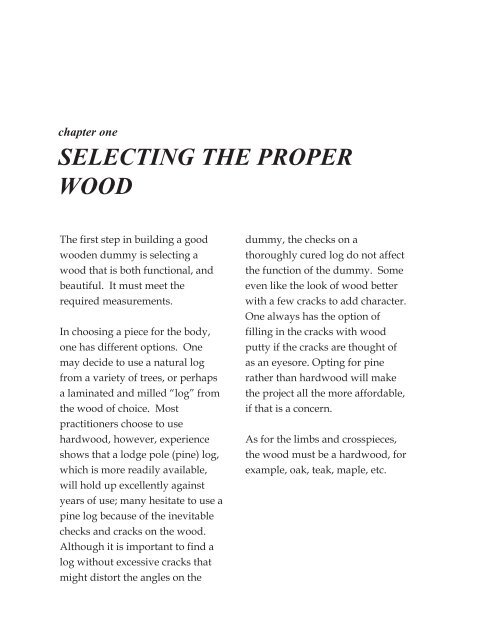You also want an ePaper? Increase the reach of your titles
YUMPU automatically turns print PDFs into web optimized ePapers that Google loves.
chapter one<br />
SELECTING THE PROPER<br />
WOOD<br />
The first step in building a good<br />
wooden dummy is selecting a<br />
wood that is both functional, and<br />
beautiful. It must meet the<br />
required measurements.<br />
In choosing a piece for the body,<br />
one has different options. One<br />
may decide to use a natural log<br />
from a variety of trees, or perhaps<br />
a laminated and milled “log” from<br />
the wood of choice. Most<br />
practitioners choose to use<br />
hardwood, however, experience<br />
shows that a lodge pole (pine) log,<br />
which is more readily available,<br />
will hold up excellently against<br />
years of use; many hesitate to use a<br />
pine log because of the inevitable<br />
checks and cracks on the wood.<br />
Although it is important to find a<br />
log without excessive cracks that<br />
might distort the angles on the<br />
dummy, the checks on a<br />
thoroughly cured log do not affect<br />
the function of the dummy. Some<br />
even like the look of wood better<br />
with a few cracks to add character.<br />
One always has the option of<br />
filling in the cracks with wood<br />
putty if the cracks are thought of<br />
as an eyesore. Opting for pine<br />
rather than hardwood will make<br />
the project all the more affordable,<br />
if that is a concern.<br />
As for the limbs and crosspieces,<br />
the wood must be a hardwood, for<br />
example, oak, teak, maple, etc.












![Til]tl](https://img.yumpu.com/45878240/1/190x245/tiltl.jpg?quality=85)




